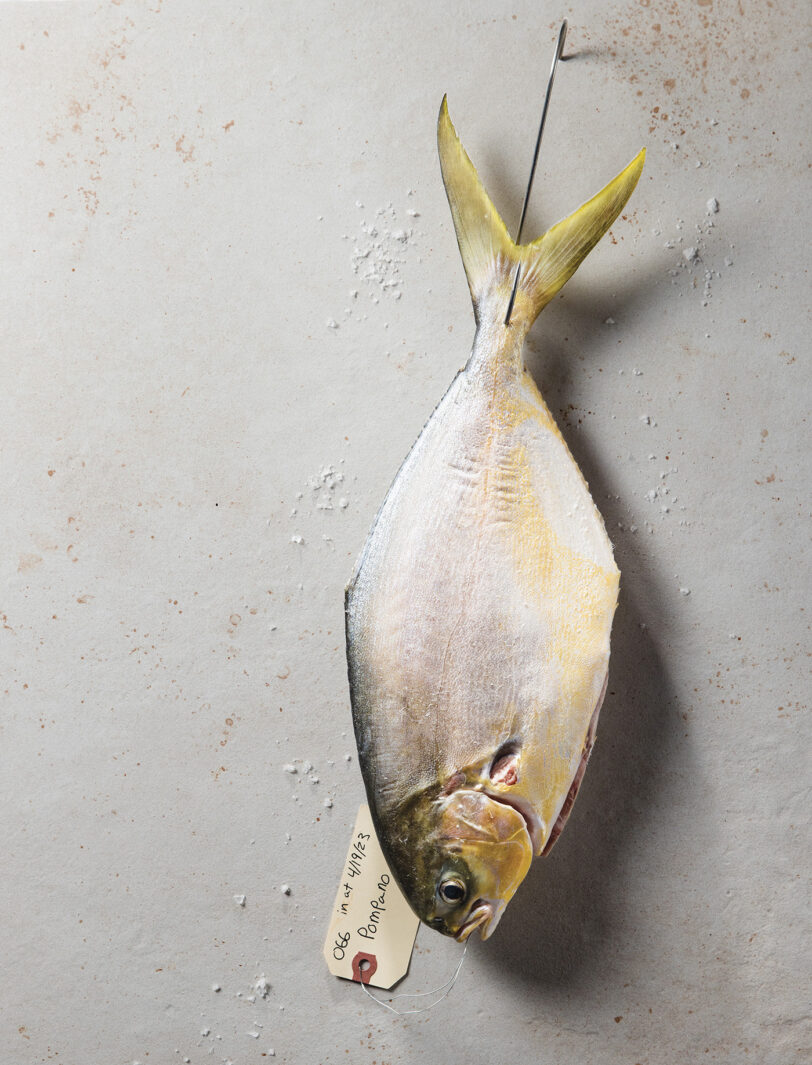Chef Lawrence Agnew knows his way around a hogfish, among others. Photos by Elizabeth Gelineau.
The first of many bragging rights of the Gulf Coast dining scene is the abundance of fresh fish. Redfish, flounder, cobia, amberjack. You name it, we have it — straight out of the water. We enjoy it freshly seasoned over the grill, sauteed in a meunire sauce or blackened with a side of hushpuppies. Therefore, at first, it might seem counterintuitive to see local, fresh-caught fish hanging in dry-aging cases at Jesse’s Restaurant in Magnolia Springs and newly opened Jesse’s On The Bay on Fort Morgan. Yet, there they are. Swordfish and amberjack. Pompano and red snapper. Lined up diagonally in cases similar to those that house their dry-aged beef.
The term “dry-aged” can be a bit misleading to the uninitiated. It’s understandable to think that dry-aging fish results in something resembling “fish jerky.” However, the term refers to the dry, cool environment the fish is stored in, not the fish itself — that is anything but dry.
While Westerners are more familiar with the idea of dry-aging beef, a process that creates tender and more flavorful steaks, we are just learning about dry-aged fish, a method that the Japanese have used for centuries. Borne out of the need to preserve food for lean times and a lack of refrigeration in past centuries, Japanese fishermen cut their catch into small pieces and preserved them in salt or vinegar or by placing them in a hot water bath. This technique proved key to survival– and a decadent one at that. In fact, with the advent of technology such as dry-aging cases, some of the most prestigious sushi restaurants in the world serve fish that was caught fresh and then aged.
The process, which can take as little as 24 hours or up to 30 days, removes the excess water from the carcass, which inhibits the growth of microorganisms. “Flavor molecues, namely glutamate and insulate, are released during the aging process, essentially adding complexity of flavor and ease of cooking, explain Jesse’s chef Laurence Agnew. “The flavor gets deeper and richer, while not making it more ‘fishy.’ It makes the fish more unctuous. You don’t see the skin become like a cracklin’ when seared or shrivel up like some species do when cooked fresh.” It is also richer and more tender, as connective tissue breaks down with time and the fat becomes more pronounced. “Dry-aging fish usually requires a shorter amount of time than beef,” says Chef Agnew. “Most species do best between three and seven days.”
Left Dry aging opens up the flavor of grilled swordfish. Right Fresh-caught fish, hang in the dry-ager to enhance flavor and remove any excess moisture.
The process starts with cleaning, gutting and scaling an excellent-quality fish. The seafood must be handled properly from the start. A gentle, swift knife technique scales the fish without bruising the flesh. The seafood must be cleaned properly or it will end up with an undesirable “fishy” flavor no matter how high the quality of the product or how long it remains in the case.
Chef Agnew stresses the importance of ensuring the catch is as fresh and humanely caught as possible, even though it hangs for several days. Jesse’s employs spearfisherman Josh Livingston of Deadknot Charters who kills the fish with a technique called “ikejime,” another Japanese approach that has spread far beyond the nation. Ikejime is not only considered the most humane method, but it also preserves the taste of the fish, allowing it to develop a savory and more complex umami flavor when aged. With this humane killing technique, the fish avoids a build of adrenaline in its body, which further improves its taste. The spearfishermen supply Jesse’s with not only classic Gulf eats such as red snapper and flounder, but with destructive lionfish, which have been decimating the Gulf ecosystem, but are moist and delicious when cooked.
Chef Agnew has enjoyed experimenting with the process, revising his methods and learning from his successes and failures. Trial and error revealed that the humidity levels need to be higher than originally thought, ideally 75-90%. “We once let a sablefish go for about 10 days or so and we found that the oiliness in the flesh got a little too soft. Now we know that a sablefish does great at around three days.” He has also found that dry-aged swordfish produces excellent results anywhere from four to 14 days; cobia does well at five days. And wild salmon, while not local, was a hit when the fat gave it a creamy, rich texture and the skin came out crispy.
The Bay area is home to some of the best fresh seafood in the world, and we are fortunate to be able to continually expand our cuisine through the hard work of local fishermen and innovative chefs. “I love to tell people to treat themselves,” Chef Agnew says. “Pay that little extra for humanely caught fish and seafood. Our chefs and fisherman take the extra time and work hard to provide a high-quality experience.” Dry-aging the fish we serve is a part of that. That extra effort always shows on the plate.”
Chef Agnew Schools MB about the Intricacies of Dry-Aged Fish

When first learning to dry-age fish, it’s usually recommended to start with the Big Four, as they call it — amberjack, king salmon, branzino and John Dory. These fish tend to do well in dry-aging by ridding the fish of any excess moisture. Depending on their size, smaller fish such as branzino and John Dory will only take 3–5 days, whereas larger species such as king salmon and amberjack can take up to two weeks due to their higher fat and oil content. Once you learn about the properties of the Big Four, you can compare their characteristics with those of local fish to determine how they will respond to dry aging.
The enzymatic processes that take place during dry aging bring a spectrum of new flavors ranging from sweet to umami. This word, which in Japanese means “tasty,” indicates a pleasant, salty flavor, mainly given by glutamate, plus other types of amino acids.
It also yields a crispy skin that we try to get guests to eat more of, as we encourage guests to eat fish from nose to tail. The stocks and sauces we make from dry-aged fish develop into rich flavors that complement our dry-aging program.
Swordfish
Swordfish is a fish that I didn’t necessarily dislike, but didn’t excite me. We found that dry-aging the swordfish for 8–18 days opens the flavor compared to eating it fresh off the boat. The texture and steaminess of the fish, especially served bone-in, is a real treat for someone who doesn’t think much of swordfish.
Tuna
This includes yellowfin, bluefin and big eye. If you try it from the third day of aging to day 30, the flavor evolves from subtly sweet and salty to having an aroma of mushrooms and mojama (Spanish air-dried tuna). The texture also becomes much denser. We use bluefin tuna sparingly because large demand in high-end sushi markets and restaurants worldwide has led to a population decline.
Cobia
Also called lemonfish, cobia is one of my favorite fish. It was the first fish I ever caught deep-sea fishing with my dad almost 30 years ago (yeesh). It is a great fish fresh, but when dry-aged (which we prefer), requires about 10-18 days depending on size. It yields deliciously crisp skin. You don’t see anyone serving cobia with skin on as much as I think you should. The size and fat content of the fish develops well and makes it more tender with a developed, clean flavor.
King Salmon
Ora King Tyee Salmon is a rare breed of Chinook salmon, highly prized because of its size of over 30 pounds. It has a high fat content and when dry-aged for at least two weeks, it presents a juicer, more tender, more succulent and more delicious salmon.
Red Snapper
We don’t dry-age them necessarily, but we will portion snapper and put them into the dry-ager just to remove any excess moisture on the skin before service time. This ensures even, crisp skin when cooked. mb









